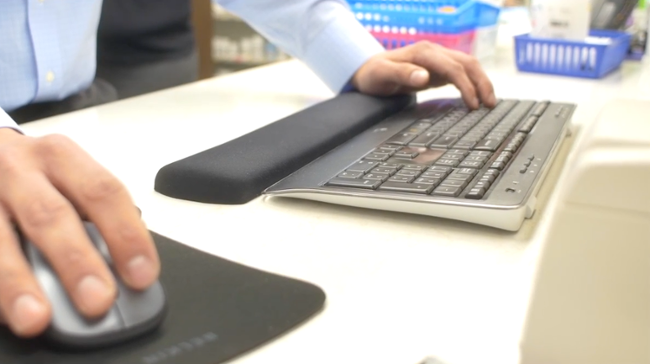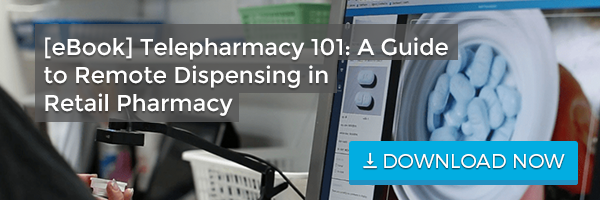How does telepharmacy work? Is it legal everywhere? Do you have more questions than answers? That’s okay — TelePharm has you covered.
Retail telepharmacy software is an innovative new solution helping independent pharmacy owners and healthcare organizations provide better access to pharmaceutical care. Because of its newness, we wanted to publish a resource for the most popular questions we hear as an industry leading retail telepharmacy software provider.
Without further ado, here are the ten most frequently asked questions about telepharmacy.

1. What is telepharmacy?
Telepharmacy is defined as “the provision of pharmaceutical care through the use of telecommunications and information technologies to patients at a distance,” according to the NABP. Think of it as the delivery of pharmaceutical care via telecommunications to patients located in areas where they may not have direct contact with a pharmacist. Although there are different applications, TelePharm is focused on retail or outpatient telepharmacy (remote dispensing) and live-video counseling.
Do you have other questions about telepharmacy? Read the article: What is Telepharmacy?
2. How does retail telepharmacy work?
A retail telepharmacy, or remote-dispensing site, is a licensed brick-and-mortar pharmacy staffed by one (or more) certified pharmacy technician. One (or more) pharmacist supervises from a managing pharmacy (remote location). A telepharmacy operates like a traditional pharmacy except the pharmacist reviews prescriptions and counsels patients from a remote location. There are four steps in the retail telepharmacy workflow: prescription arrival, image capture, pharmacist review and live-video patient counseling.
Interested in more workflow details? Watch our short video: How Retail Telepharmacy Works.
3. Is telepharmacy safe? Is TelePharm HIPAA-compliant?
Telepharmacy is a safe practice of pharmacy, and advances in modern technology allow remote dispensing software to ensure the highest level of safety and security for patients, pharmacists and technicians. In a study performed as part of the North Dakota Telepharmacy Project, telepharmacy sites reported a lower overall medication dispensing error rate than standard, traditional pharmacies.
TelePharm stores all data inside of secure, HIPAA-compliant servers. Our team maintains a closed and encrypted system, ensuring that we meet all the requirements of HIPAA compliance. We also use 256-bit SSL encryption, the industry standard for protecting your patient health information.
4. Is telepharmacy allowed everywhere?
As of the writing of this article, roughly 20 states currently have language outlining the practice of telepharmacy, but in general, telepharmacy laws and regulations are very fragmented. Each state board of pharmacy has developed its own telepharmacy language, which means it’s allowed on a state-by-state basis.
Do you want to know if telepharmacy is approved in your state? View our updated map of telepharmacy law and regulations.
Have a question pertaining to your state? Submit a question to Jessica Adams, PharmD, our regulatory expert at TelePharm.
5. What are the benefits of telepharmacy compared to traditional pharmacy?
A telepharmacy provides all the care and services of a traditional pharmacy, and can operate in areas where a traditional pharmacy is not financially feasible. The collaborative staffing model makes this possible. Pharmacists located at a managing pharmacy, or home pharmacy, supervise remote-dispensing sites in addition to their own pharmacy by way of our industry-leading, easy-to-use retail telepharmacy software. This allows pharmacies to capture more prescriptions and build a patient-pharmacist relationship with new patients.
Telepharmacy is also a safe and secure practice of pharmacy and helps reduce human errors and workflow inefficiencies.
6. Is telepharmacy creating jobs for pharmacists and technicians or replacing them?
Telepharmacy is creating new jobs for pharmacists and technicians in rural, urban and underserved areas. It provides more opportunities for pharmacists to be included as part of the patient-care team, and it also helps expand their reach into medically underserved areas. Instead of replacing pharmacists’ jobs, it’s guaranteeing their jobs by supplementing more prescriptions and new patients from a larger geographic area.
Additionally, telepharmacy is elevating the role of the pharmacy technician. They say a technician is the “backbone” of the pharmacy. In a telepharmacy, the technician is the backbone, spine, vertebrae, muscle tissue, cartilage — you get the point. They are critical to the success of a retail or outpatient telepharmacy, and remote-dispensing sites are creating more opportunities for them to take their career to the next level.
7. What about CII prescriptions? Are they allowed at a telepharmacy?
It depends on state regulations, but currently every state that allows retail telepharmacy also allows controlled prescription drugs in telepharmacies. Typically there are additional policies and procedures surrounding the management and dispensing of CII’s (separate lock and key, perpetual inventory, etc), but it is allowed.
8. Does TelePharm integrate with my Pharmacy Management System?
We support a number of Pharmacy Management Systems (please see below) and, in the case where we don’t currently support yours, our team of developers will build one at no cost to you. We can even make it work if you are using different Pharmacy Management Systems in multiple stores. Below is a list of pharmacy management systems we currently integrate with:
ComputerRx | Pharmaserv | Rx30 | QS1 | BestRx | Speed Script | Micro Merchants | EnterpriseRx | PioneerRx | PDX |RxKey | Framework Direct | PharmacyRx | Cerner
Don’t see your pharmacy management system on the list? Don’t fret! Our team of developers can create a seamless and inclusive integration with your PMS, no problem. Contact us to learn more.
9. How does retail telepharmacy software compare to a kiosk or an automated pharmacy system?
The main benefit of a brick-and-mortar telepharmacy is direct access to a pharmacist. A telepharmacy is staffed by a technician and managed by a remote pharmacist. This model enables the patient to receive more personalized care, is cost-effective for the pharmacy owner, and is also what we consider to be the next best option to having a pharmacist physically present.
Kiosks incorporate an extremely limited inventory, are very expensive to set up and patient medication adherence tends to struggle in this medication delivery model. A telepharmacy provides the foundation to build and foster a patient-pharmacist relationship which helps keeps patients adherent to their medication regimes.
10. Is telepharmacy a good way for independents to compete with big box pharmacies?
Retail telepharmacy is a fantastic way for independent community pharmacies to stay competitive in today’s dynamic pharmacy marketplace. The collaborative staffing model makes it a great tool for community pharmacy, and independents can also implement telepharmacy much quicker than big box stores.
Looking for other ways to compete with big box pharmacies? Read our article: 5 Ways to Make Your Independent Pharmacy More Competitive.
Thanks for reading our most popular questions about telepharmacy! If you're looking to learn more, download our retail telepharmacy beginner's guide by clicking here.



